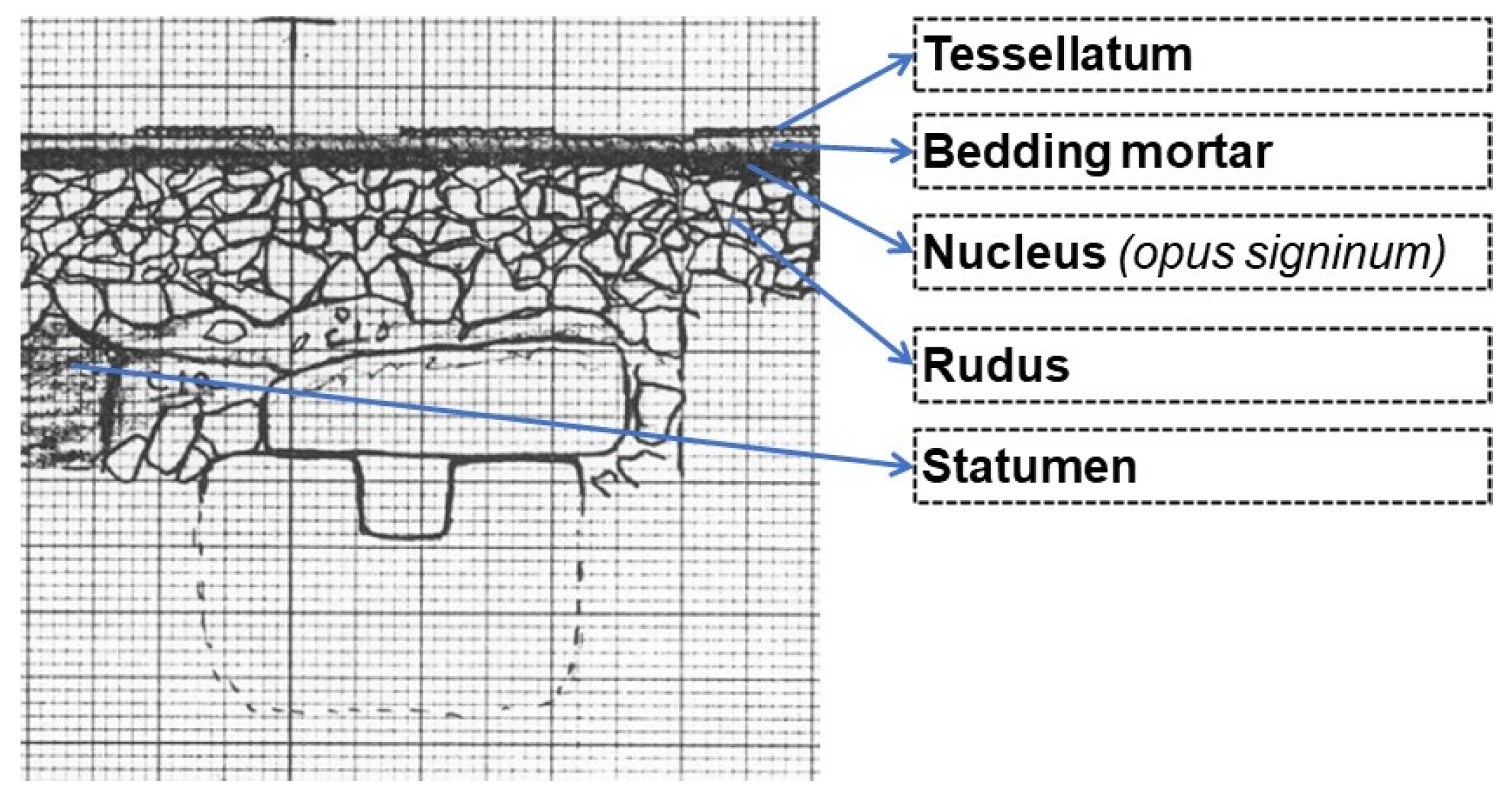Archaeological and Chemical Investigation on the High Imperial Mosaic Floor Mortars of the Domus Integrated in the Museum of Archaeology D. Diogo de Sousa, Braga, Portugal
Abstract
:1. Introduction
1.1. Archaeological Background
1.2. The Bracara Augusta Mosaics and the Findings of the Stables Archaeological Site
1.3. The Presence of Marble and Lime in Bracara Augusta
2. Description and Conservation of the Mosaic’s Pavement
3. Materials and Methods
3.1. Materials
3.2. Methods
4. Results and Discussion
5. Conclusions
Author Contributions
Funding
Institutional Review Board Statement
Informed Consent Statement
Data Availability Statement
Acknowledgments
Conflicts of Interest
References
- Silva, A.S.; Paiva, M.; Ricardo, J.; Salta, M.M.; Monteiro, A.M.; Candeias, A.E. Characterisation of Roman mortars from the archaeological site of Tróia (Portugal). Mater. Sci. Forum 2006, 514–516, 1643–1647. [Google Scholar] [CrossRef]
- Cardoso, I.; Macedo, M.F.; Vermeulen, F.; Corsi, C.; Santos Silva, A.; Rosado, L.; Candeias, A.; Mirao, J. A multidisciplinary approach to the study of archaeological mortars from the town of Ammaia in the Roman province of Lusitania (Portugal)*. Archaeometry 2014, 56, 1–24. [Google Scholar] [CrossRef] [Green Version]
- Borsoi, G.; Santos Silva, A.; Menezes, P.; Candeias, A.; Mirão, J. Analytical characterization of ancient mortars from the archaeological Roman site of Pisões (Beja, Portugal). Constr. Build Mater. 2019, 204, 597–608. [Google Scholar] [CrossRef] [Green Version]
- Velosa, A.L.; Coroado, J.; Veiga, M.R.; Rocha, F. Characterisation of roman mortars from Conímbriga with respect to their repair. Mater. Charact. 2007, 58, 1208–1216. [Google Scholar] [CrossRef]
- Pachta, V.; Stefanidou, M. Technology of multilayer mortars applied in ancient floor mosaic substrates. J. Archaeol. Sci. 2018, 20, 683–691. [Google Scholar] [CrossRef]
- Izzo, F.; Arizzi, A.; Cappelletti, P.; Cultrone, G.; De Bonis, A.; Germinario, C.; Graziano, F.; Grifa, C.; Guarino, V.; Mercurio, M.; et al. The art of building in the Roman period (89 B.C.–79 A.D.): Mortars, plasters and mosaic floors from ancient Stabiae (Naples, Italy). Constr. Build. Mater. 2016, 117, 129–143. [Google Scholar] [CrossRef]
- Kramar, S.; Zalar, V.; Urosevic, M.; Körner, W.; Mauko, A.; BMirtič, B.; Lux, J.; Mladenović, A. Mineralogical and microstructural studies of mortars from the bath complex of the Roman villa rustica near Mošnje (Slovenia). Mater. Charact. 2011, 62, 1042–1057. [Google Scholar] [CrossRef]
- Ergenç, D.; Fort, R. Multi-technical characterization of Roman mortars from Complutum, Spain. Measurement 2019, 147, 106876. [Google Scholar] [CrossRef]
- Moreno-Alcaide, M.; Compaña-Prieto, J.M. Roman plasters and mortars from ancient Cosa (Tuscany-Italy). Mineralogical characterisation and construction from domus 10.1 (House with Cryptoporticus). J. Archaeol. Sci. 2018, 19, 127–137. [Google Scholar] [CrossRef]
- Starinieri, V.; Papayianni, I.; Stefanidou, M. Study of materials and technology of ancient floor mosaics’ substrate. Conservar. Património 2008, 7, 29–34. [Google Scholar] [CrossRef]
- Miriello, D.; Barca, D.; Bloise, A.; Ciarallo, A.; Crisci, G.M.; De Rose, T.; Gattuso, C.; Gazineo, F.; La Russa, M.F. Characterisation of archaeological mortars from Pompeii (Campania, Italy) and identification of construction phases by compositional data analysis. J. Archaeol. Sci. 2010, 37, 2207–2223. [Google Scholar] [CrossRef]
- Leone, G.; De Vita, A.; Magnani, A.; Rossi, C. Characterization of archaeological mortars from Herculaneum. Thermochim. Acta 2016, 624, 86–94. [Google Scholar] [CrossRef]
- Martins, M.; Carvalho, H. Roman city of Bracara Augusta (Hispania Citerior Tarraconensis): Urbanism and territory occupation. Agri Centuriate 2017, 14, 79–98. [Google Scholar]
- Martins, M. Bracara Augusta: A Roman town in the Atlantic area. In Journal of Roman Archaeology; JRA Supplementary Series 62; Thomson-Shore: Dexter, MI, USA, 2006; pp. 213–222. [Google Scholar]
- Martins, M.; Braga, C.; Magalhães, F.; Ribeiro, J. Constructing identities within the periphery of the Roman Empire: North-west Hispania. In Rome and Barbaricum. Contributions to the Archaeology and History of Interaction in European Protohistory; Curcă, R.G., Rubel, A., Symonds, R., Voß, H.U., Eds.; Archaeopress: Oxford, UK, 2020; pp. 135–154. [Google Scholar]
- Delgado, M.; Gaspar, A.M. Intervençâo arqueológica na Zona P1 (Antigas cavalariças do regimento de infanteria de Braga)—Archaeological intervention in zone P1 (Old stables of the Braga infantry regiment). Cad. Arqueol. 1986, 3, 155–167. [Google Scholar]
- Martins, M.; Carvalho, H. Bracara Augusta and the changing rural landscape. In Changing Landscapes. The Impact of Roman Towns in the Western Mediterranean, Proceedings of the International Colloquium, Castelo de Vide, Marvão, Portugal, 15–17 May 2008; Corsi, C., Vermeulen, F., Eds.; Ante Quem: Bologna, Italy, 2010; pp. 281–298. [Google Scholar]
- Martins, M.; Mar, R.; Ribeiro, J.; Magalhães, F. The Roman theatre of Bracara Augusta. In Proceedings of the XVIII CIAC: Centre and Periphery of the Ancient World, Mérida, Spain, 13–17 May 2013; pp. 861–864. [Google Scholar]
- Magalhães, F. The Roman Domus on the NO Peninsula. Architecture, Construction and Sociability. Ph.D. Thesis, University of Minho, Braga, Portugal, 2019. (In Portuguese). [Google Scholar]
- Delgado, M.; Martins, M. Intervençao arqueológica na Zona P1 (Antiguas cavalariças do regimento de infanteria de Braga)—Archaeological intervention in zone P1 (Old stables of the Braga Infantry Regiment). Cad. Arqueol. 1988, 5, 79–93. [Google Scholar]
- Abraços, F.; Wrench, L. The Roman mosaics of Bracara Augusta: Re-reading and reinterpretation of decorative motifs. J. Mosaic Res. 2017, 10, 9–26. [Google Scholar] [CrossRef] [Green Version]
- Abraços, F.; Lima, A.M.C.; Mourão, C.; Limão, F.; Wrench, L.; Pinto, M.M.; Gomes, P.D.; Lopes, R. The Corpvs of the Roman Mosaics of Conventvs Bracaravgvstanvs; Centro de Estudos Históricos: Lisbon, Portugal, 2019. [Google Scholar]
- Martins, M.; Magalhães, F.; Peñín, R.; Ribeiro, J. The housing evolution of Braga between late Antiquity and the early Middle Ages. In Arqueologia Medieval. Hàbitats Medievals; Sabaté, F., Brufal, J., Eds.; Pagès Editors: Lleida, Spain, 2016; pp. 35–52. [Google Scholar]
- Abraços, F. Conservation et restauration des mosaïques romaines au Portugal—Quelques exemples dans les collections de musées. In Lessons Learned: Reflecting on the Theory and Practice of Mosaic Conservation; Proceedings of the 9th ICCM Conference, Hammamet, Tunisia, 29 November–3 December 2005; Khader, B., Abed, A.B., Demas, M., Roby, T., Eds.; Getty Publications: Los Angeles, CA, USA, 2008; pp. 69–74. [Google Scholar]
- Martins, M.; Carvalho, H. Transforming the territory: Bracara Augusta and its Roman cadaster. Rev. Historiogr. 2016, 25, 219–243. [Google Scholar]
- Ferreira, N. Geological Chart of Portugal in Scale 1:50,000—Sheet 5-D, Braga; Ministério da Economia, Instituto Geológico Mineiro, Departamento de Geologia: Lisboa, Portugal, 2000. [Google Scholar]
- Antunes, I.M.H.R.; Gonçalves, L.M.B. The “Sete Fontes” groundwater system (Braga, NW Portugal): Historical milestones and urban assessment. Sustain. Water Resour. Manag. 2018, 5, 235–248. [Google Scholar] [CrossRef]
- Prudêncio, M.I. Ceramic in ancient societies: A role for nuclear methods of analysis. In Nuclear Chemistry: New Research; Koskinen, A.N., Ed.; Nova Science Publishers, Inc.: Hauppauge, NY, USA, 2008; Volume 2, pp. 51–81. [Google Scholar]
- Ribeiro, J.; Martins, M. Os materiais de construção em Bracara Augusta. In História da Construção—Os Materiais; Melo, A., Ribeiro, M.V., Eds.; CITEM: Braga, Portugal, 2012; pp. 15–34. [Google Scholar]
- Taelman, D.; Elburg, M.; Smet, I.; De Paepe, P.; Lopes, L.; Vanhaecke, F.; Vermeulen, F. Roman marble from Lusitania: Petrographic and geochemical characterisation. J. Archaeol. Sci. 2013, 40, 2227–2236. [Google Scholar] [CrossRef] [Green Version]
- Ribeiro, J. Arquitectura em Bracara Augusta. Uma análise das Técnicas Edilícias; Afrontamento: Porto, Portugal, 2013. [Google Scholar]
- Cazes, Q.; Areamond, J.C. Les fouilles du musée Saint Raymond à Toulouse (1994–1996). In Mémoires de la Société Archeólogique du Midi de la France; Conseil Général de La Haute-Garonne; Centre Atio Al D’études Spatiales: Toulouse, France, 1997; pp. 35–53. [Google Scholar]
- Perrault, C. Les Dix Livres d’Architecture de Vitruve; Pierre Mardaga Editeur: Liège, France, 1996. [Google Scholar]
- Fragata, A. Study of the mortar support of the mosaics of the imperial domus integrated in the space crypt of the regional museum of archaeology D. Diogo de Sousa (MDDS). In Proceedings of the XIV A.D. Saeculum Augustum—The Age of Augustus International Conference, Lisbon, Portugal, 24–26 September 2014. (In Portuguese). [Google Scholar]
- Fragata, A. Compatible Renders for Masonries Submitted to Severe Water Action. Ph.D. Thesis, University of of Aveiro, Aveiro, Portugal, 2013. (In Portuguese). [Google Scholar]
- Veiga, R.; Fragata, A.; Tavares, M.; Magalhães, A.; Ferreira, N. Inglesinhos convent: Compatible renders and other measures to mitigate water capillary rising problems. J. Build. Apprais. 2009, 5, 171–185. [Google Scholar] [CrossRef] [Green Version]
- Alonso-Olazabal, A.; Ortega, L.A.; Zuluaga, M.C.; Ponce-Antón, G.; Jiménez Echevarría, J.; Fernández, A.C. Compositional characterization and chronology of roman mortars from the archaeological site of Arroyo de la Dehesa de Velasco (Burgo de Osma—Ciudad de Osma, Soria, Spain). Minerals 2020, 10, 393. [Google Scholar] [CrossRef]
- Miriello, D.; Bloise, A.; Crisci, G.M.; De Luca, R.; De Nigris, B.; Martellone, A.; Osanna, M.; Pace, R.; Pecci, A.; Ruggieri, N. New compositional data on ancient mortars and plasters from Pompeii (Campania—Southern Italy): Archaeometric results and considerations about their time evolution. Mater. Charact. 2018, 146, 189–203. [Google Scholar] [CrossRef]
- Lubelli, B.; Nijland, T.; Hees, R. Self-healing of lime based mortars: Microscopy observations on case studies. Heron 2011, 56, 75–91. [Google Scholar]
- Ontiveros-Ortega, E.; Rodríguez-Gutiérrez, O.; Navarro, A. Mineralogical and physical-chemical characterization of Roman mortars used for monumental substrates on the hill of San Antonio, in the Roman city of Italica (prov. Baetica, Santiponce, Seville, Spain). J. Archaeol. Sci. Rep. 2016, 7, 205–223. [Google Scholar]
- Daoudi, L.; Rocha, F.; Costa, C.; Arrebei, N.; Fagel, N. Characterization of rammed earth materials from the XVIth century. Badii palace in Marrakech, Morocco to ensure authentic and reliable restoration. Geoarchaeology 2017, 33, 529–541. [Google Scholar] [CrossRef]
- Fragata, A.; Veiga, R.; Velosa, A. Substitution ventilated render systems for historic masonry: Salt crystallization tests evaluation. Const. Build. Mater. 2016, 102, 592–600. [Google Scholar] [CrossRef]
- Liritzis, I.; Xanthopoulou, V.; Palamara, E.; Papageorgiou, I.; Iliopoulos, I.; Zacharias, N.; Vafiadou, A.; Karydas, A. Characterization and provenance of ceramic artifacts and local clays from late Mycenaean Kastrouli (Greece) by means of p-XRF screening and statistical analysis. J. Cult. Herit. 2020, 46, 61–81. [Google Scholar] [CrossRef]
- Papageorgiou, I. Ceramic investigation: How to perform statistical analyses. Archaeol. Anthrop. Sci. 2020, 12, 210. [Google Scholar] [CrossRef]

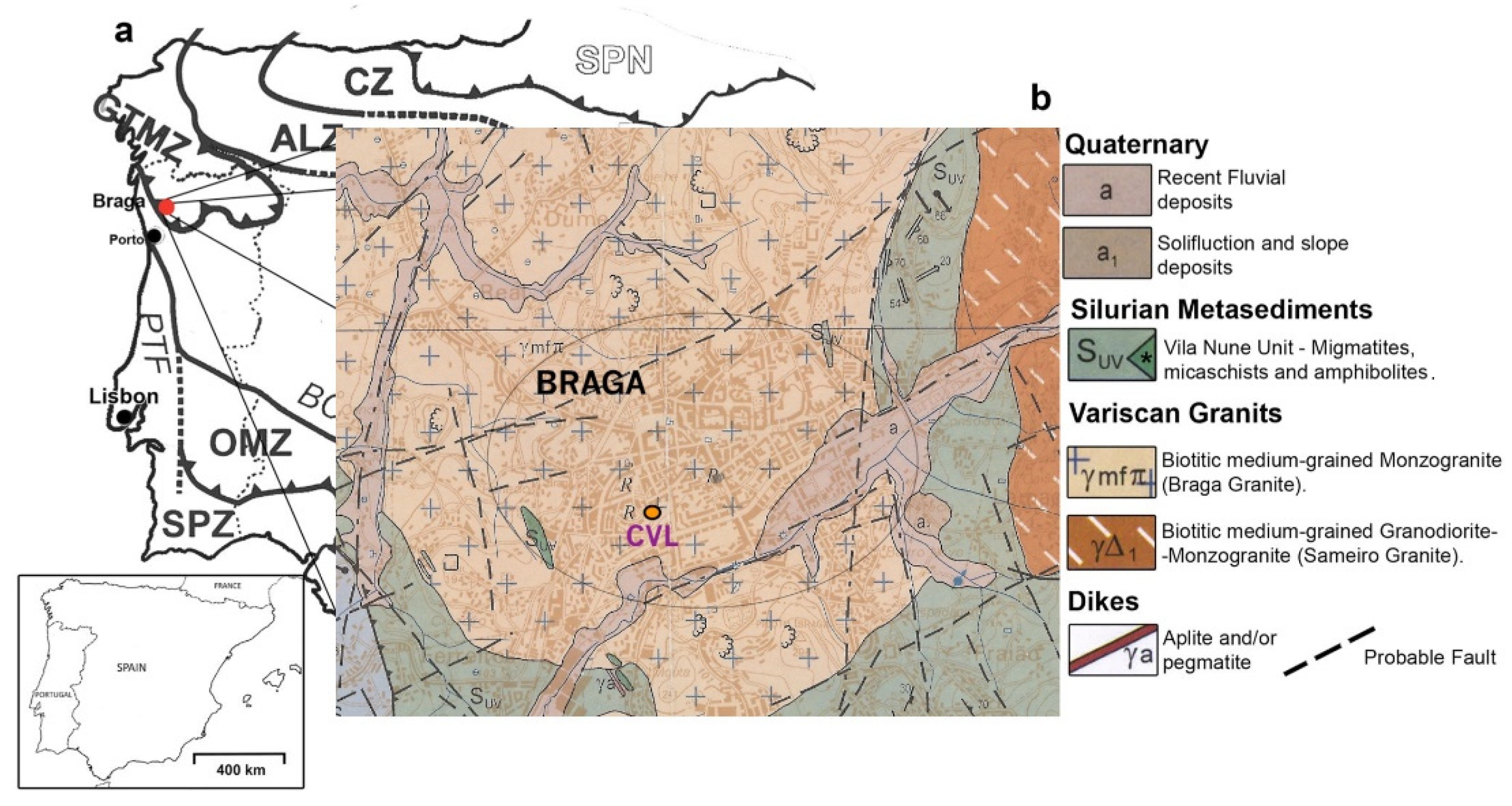
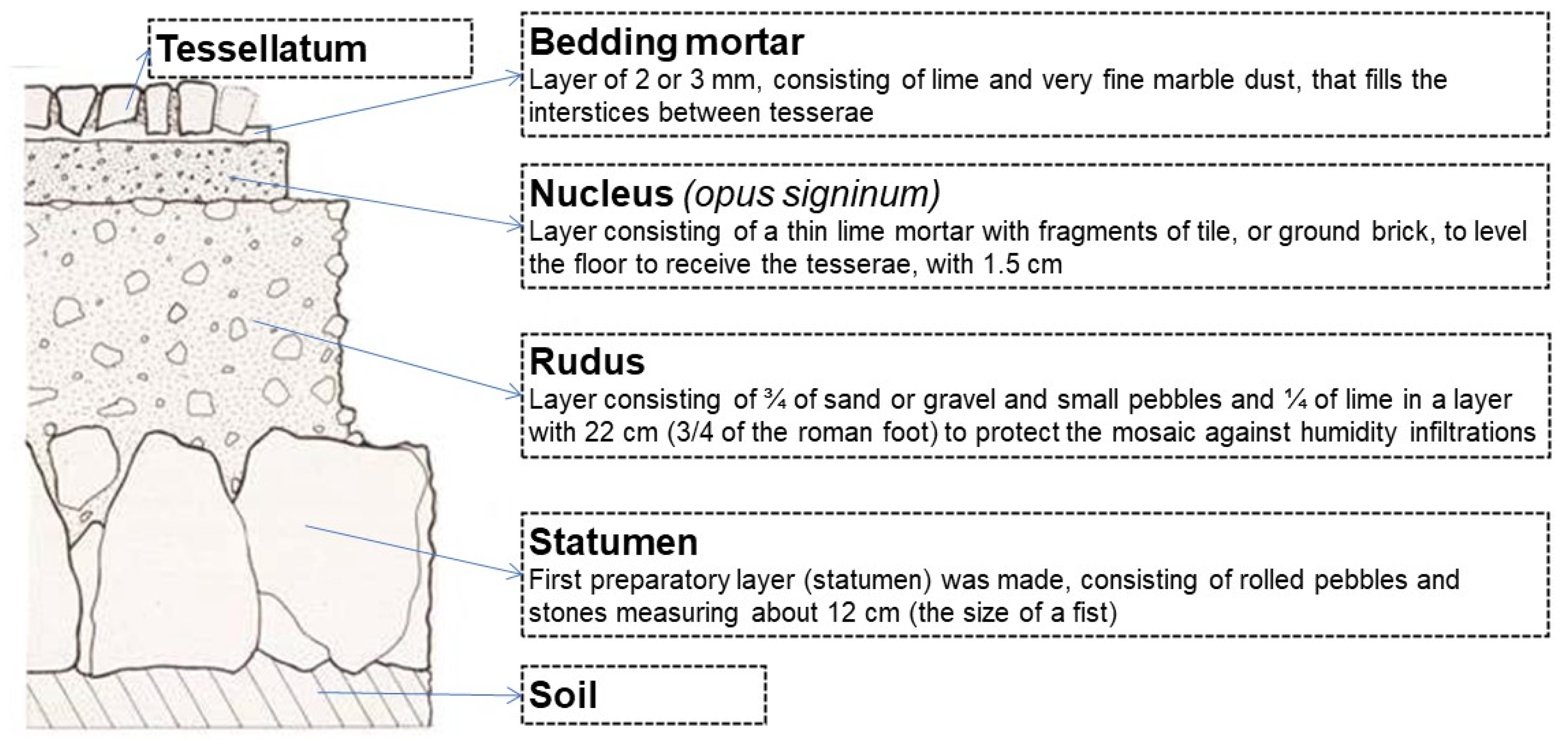
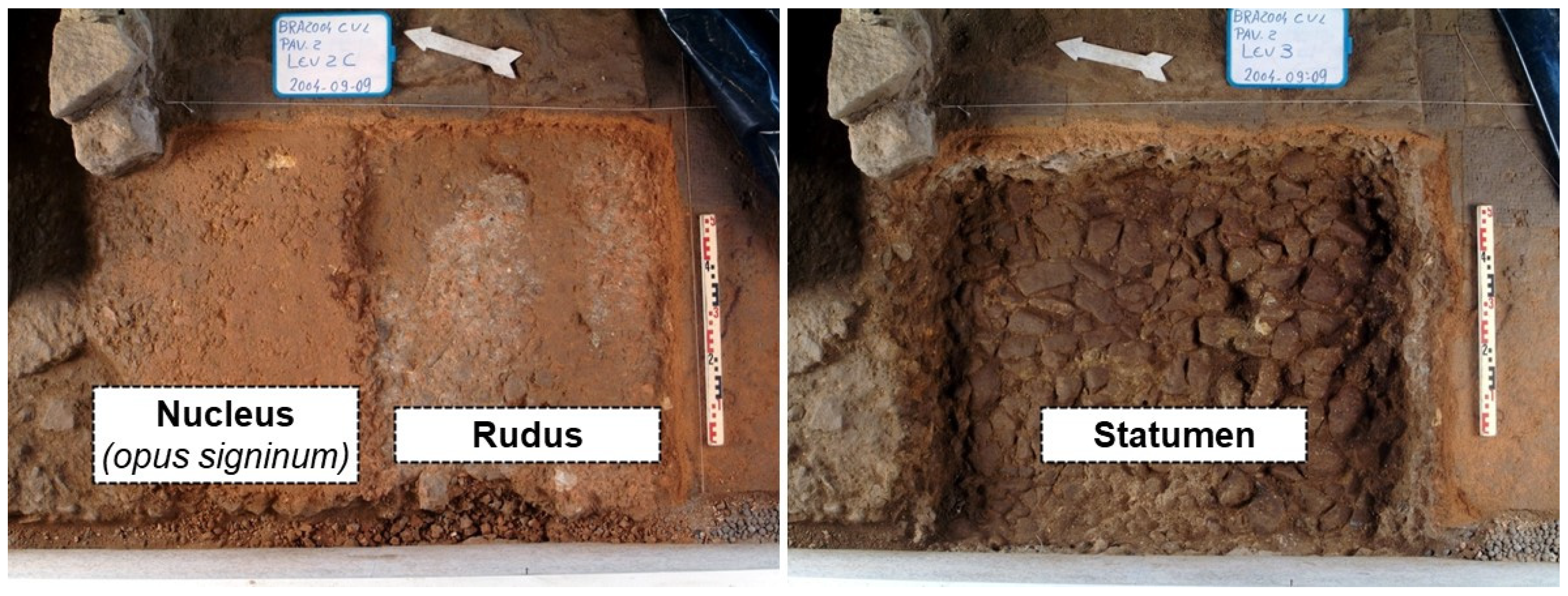
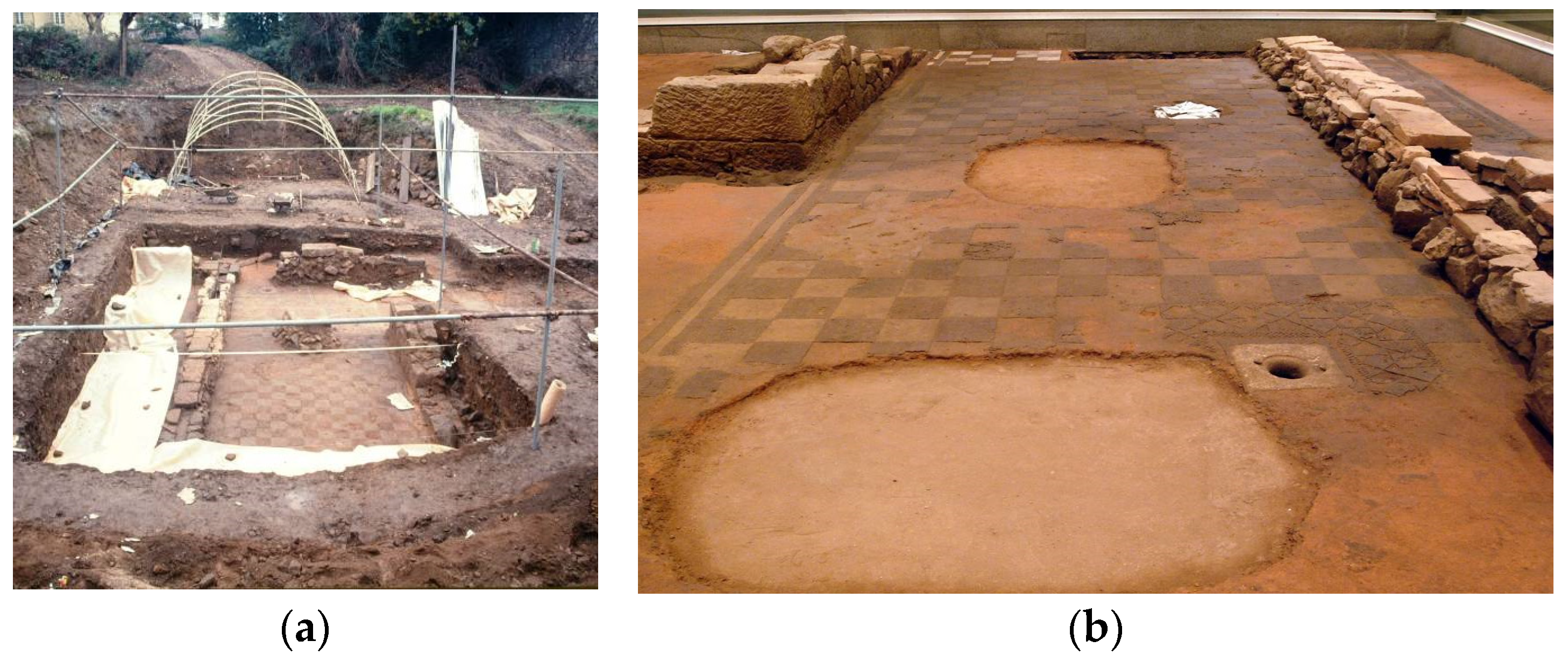

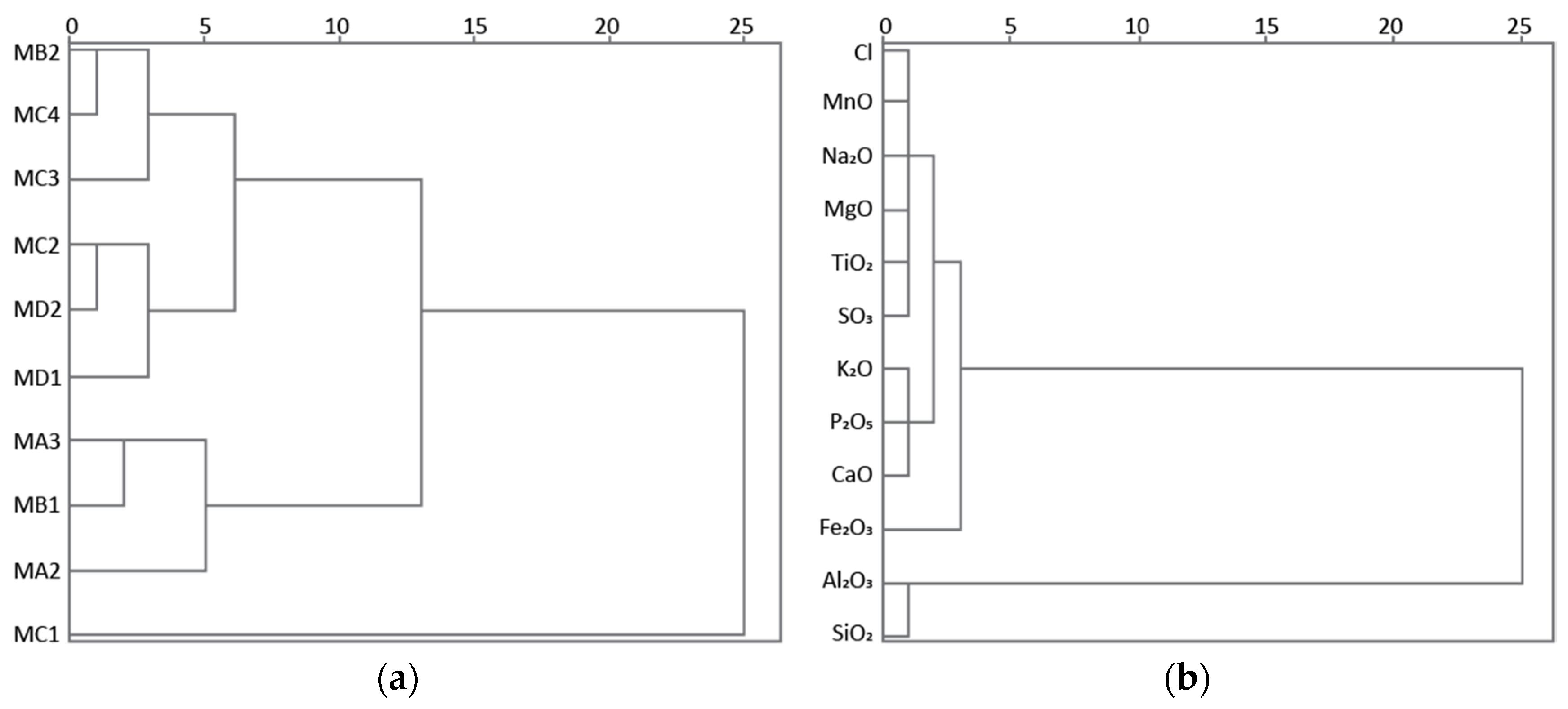
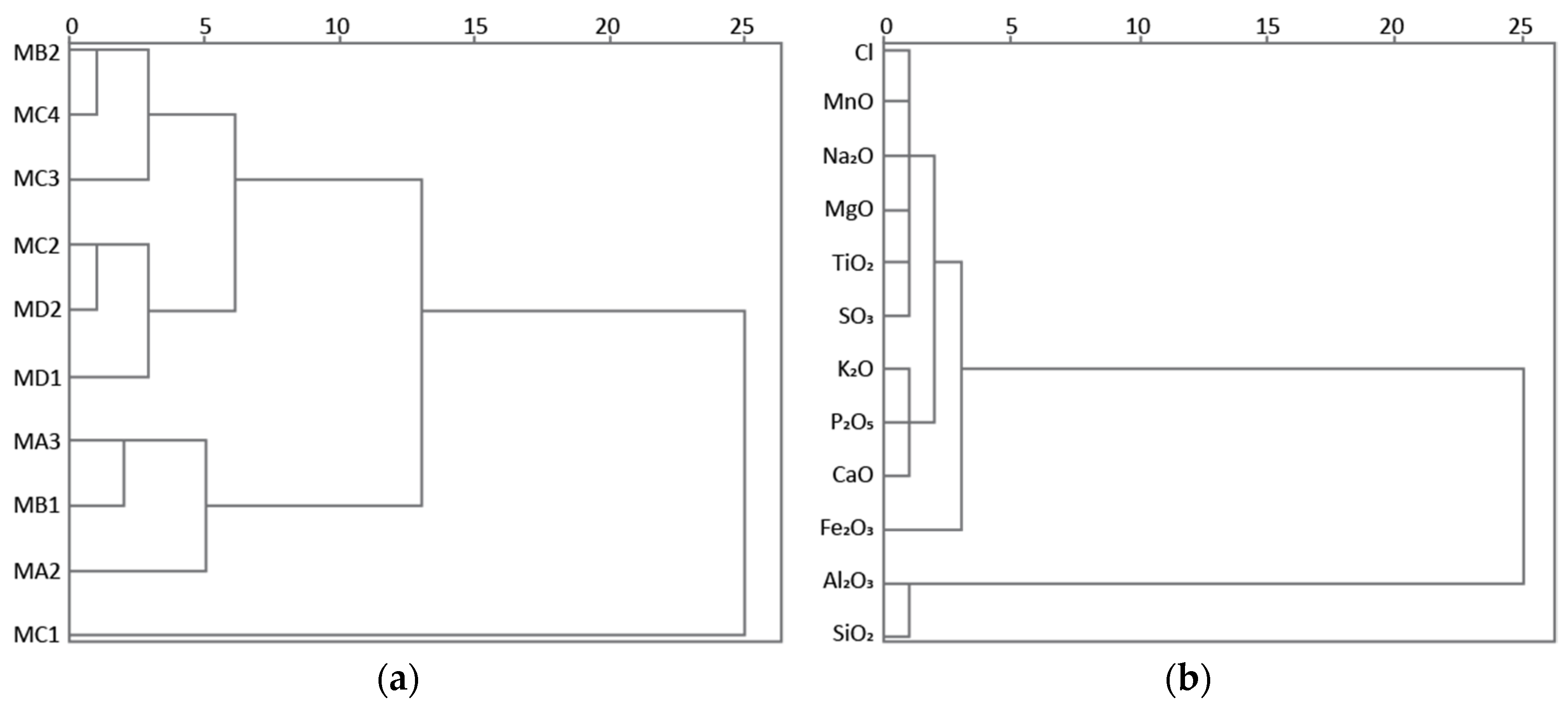
| Layer 1: Nucleus—Opus Signinum (Upper Zone of the Layer) | |||||
| Description | Removal depth: ~ 1.0/3.0 cm; color: reddish. | ||||
 |  |  |  |  | |
| Sample | MA2 | MA3 | MB1 | MC1 | MD1 |
| Layer 2: Nucleus—Opus Signinum (Lower Zone of the Layer) | |||||
| Description | Removal depth: ~3.0/5.0 cm; color: reddish. | ||||
 |  |  |  |  | |
| Sample | MB2 | MC2 | MC3 | MC4 | MD2 |
| Layer | Layer 3: Between Nucleus and Rudus | Layer 4: Rudus | Layer 5: Statumen | ||
| Description | Removal depth: ~5 cm; color: pinkish | Removal depth: ~5/10 cm; color: brown | Removal depth: ~25/30 cm; color: dark brown | ||
 |  |  | |||
| Sample | MA4 | MD3 | MA1 | ||
| Sample | Na2O | MgO | Al2O3 | SiO2 | P2O5 | SO3 | Cl | K2O | CaO | TiO2 | MnO | Fe2O3 | LOI |
|---|---|---|---|---|---|---|---|---|---|---|---|---|---|
| MA2 | 0.34 | 1.10 | 30.93 | 35.42 | 2.98 | 0.24 | 0.13 | 2.60 | 5.11 | 1.25 | 0.06 | 8.38 | 11.24 |
| MA3 | 0.30 | 1.16 | 32.49 | 37.07 | 1.50 | 0.40 | 0.10 | 2.68 | 3.65 | 1.30 | 0.07 | 8.48 | 10.62 |
| MB1 | 0.27 | 1.35 | 32.68 | 38.53 | 3.45 | 0.86 | 0.04 | 3.43 | 2.14 | 1.35 | 0.13 | 8.62 | 6.93 |
| MC1 | 0.33 | 0.97 | 29.27 | 31.87 | 4.64 | 3.82 | 0.11 | 2.46 | 5.48 | 1.12 | 0.10 | 7.58 | 11.96 |
| MD1 | 0.43 | 1.11 | 33.02 | 32.90 | 4.57 | 0.41 | 0.19 | 2.76 | 3.85 | 1.27 | 0.11 | 8.63 | 10.53 |
| MB2 | 0.18 | 1.28 | 34.97 | 36.16 | 3.46 | 0.35 | 0.03 | 2.86 | 1.52 | 1.37 | 0.09 | 8.91 | 8.59 |
| MC2 | 0.26 | 0.99 | 34.09 | 34.63 | 4.35 | 0.32 | 0.10 | 2.52 | 2.41 | 1.22 | 0.17 | 8.09 | 10.63 |
| MC3 | 0.22 | 1.14 | 34.03 | 35.65 | 3.87 | 0.26 | 0.03 | 3.35 | 1.46 | 1.62 | 0.10 | 11.07 | 6.84 |
| MC4 | 0.19 | 1.35 | 35.93 | 36.42 | 3.50 | 0.17 | 0.07 | 2.70 | 1.70 | 1.28 | 0.16 | 8.50 | 7.78 |
| MD2 | 0.43 | 1.47 | 34.08 | 34.91 | 3.39 | 0.23 | 0.15 | 3.26 | 2.41 | 1.38 | 0.08 | 8.69 | 9.22 |
| MA4 | 1.11 | 2.25 | 22.27 | 47.31 | 0.74 | 0.21 | 0.07 | 6.70 | 5.60 | 1.37 | 0.10 | 7.01 | 4.83 |
| MD3 | 1.74 | 1.70 | 20.71 | 54.06 | 1.98 | 0.07 | 0.03 | 7.07 | 2.01 | 1.22 | 0.07 | 6.22 | 2.76 |
| MA1 | 0.23 | 1.56 | 26.11 | 47.56 | 0.86 | 0.13 | 0.03 | 4.73 | 1.11 | 1.54 | 0.13 | 7.80 | 7.77 |
| Sample | As | Ba | Br | Co | Cr | Cs | Cu | Ga | Nb | Ni | Pb | Rb | Sn | Sr | Th | V | Zn | Zr |
|---|---|---|---|---|---|---|---|---|---|---|---|---|---|---|---|---|---|---|
| MA2 | 23.1 | 350 | 60.2 | 5.6 | 45.4 | 18.6 | 23.7 | 36.0 | 31.4 | 11.6 | 59 | 270 | 28.4 | 85 | 36.4 | 50.4 | 77 | 300 |
| MA3 | 17.3 | 360 | 52.4 | 5.1 | 47.4 | 22.2 | 27.0 | 37.1 | 32.3 | 13.3 | 51 | 250 | 23.2 | 65 | 37.0 | 56.1 | 87 | 300 |
| MB1 | 51.9 | 520 | 30.6 | 8.4 | 46.4 | 20.8 | 67.2 | 34.5 | 29.2 | 13.8 | 71 | 290 | 21.0 | 160 | 42.2 | 67.9 | 170 | 340 |
| MC1 | 55.6 | 420 | 67.4 | 8.6 | 40.1 | 20.6 | 55.8 | 33.3 | 29.9 | 11.2 | 240 | 240 | 21.9 | 87 | 34.2 | 60.6 | 78 | 250 |
| MD1 | 24.9 | 440 | 85.8 | 8.4 | 50.0 | 18.6 | 57.5 | 37.3 | 32.2 | 14.3 | 56 | 250 | 23.6 | 90 | 37.9 | 57.3 | 190 | 280 |
| MB2 | 76.6 | 380 | 35.1 | 8.8 | 51.8 | 19.8 | 55.7 | 38.1 | 33.5 | 13.7 | 61 | 260 | 24.4 | 70 | 40.9 | 63.6 | 120 | 310 |
| MC2 | 58.5 | 330 | 65.0 | 15.2 | 45.6 | 18.9 | 71.4 | 36.1 | 32.2 | 12.4 | 170 | 250 | 23.6 | 67 | 36.2 | 69.6 | 130 | 270 |
| MC3 | 61.5 | 560 | 38.1 | 8.0 | 58.3 | 22.2 | 58.9 | 44.7 | 37.6 | 14.6 | 660 | 290 | 29.6 | 88 | 48.1 | 87.5 | 130 | 400 |
| MC4 | 45.7 | 370 | 42.1 | 15.6 | 48.4 | 20.5 | 62.5 | 38.0 | 34.3 | 13.2 | 77 | 250 | 25.1 | 59 | 36.8 | 68.0 | 200 | 300 |
| MD2 | 25.3 | 440 | 65.4 | 4.9 | 48.2 | 19.9 | 64.0 | 36.1 | 31.3 | 15.0 | 53 | 270 | 21.3 | 89 | 39.2 | 65.7 | 190 | 340 |
| MA4 | 4.9 | 950 | 20.3 | 7.3 | 32.9 | 17.5 | 35.3 | 21.2 | 18.6 | 7.8 | 44 | 380 | 10.5 | 210 | 37.8 | 62.5 | 170 | 450 |
| MD3 | 14.4 | 970 | 12.5 | <LOD | 41.0 | 15.0 | 36.8 | 20.1 | 16.0 | 8.6 | 38 | 400 | 10.7 | 260 | 36.5 | 61.8 | 82 | 400 |
| MA1 | 42.1 | 560 | 23.4 | 7.3 | 60.9 | 12.5 | 57.8 | 22.0 | 19.0 | 12.1 | 44 | 330 | 9.4 | 92 | 41.7 | 77.2 | 83 | 540 |
Publisher’s Note: MDPI stays neutral with regard to jurisdictional claims in published maps and institutional affiliations. |
© 2021 by the authors. Licensee MDPI, Basel, Switzerland. This article is an open access article distributed under the terms and conditions of the Creative Commons Attribution (CC BY) license (https://creativecommons.org/licenses/by/4.0/).
Share and Cite
Fragata, A.; Ribeiro, J.; Candeias, C.; Velosa, A.; Rocha, F. Archaeological and Chemical Investigation on the High Imperial Mosaic Floor Mortars of the Domus Integrated in the Museum of Archaeology D. Diogo de Sousa, Braga, Portugal. Appl. Sci. 2021, 11, 8267. https://doi.org/10.3390/app11178267
Fragata A, Ribeiro J, Candeias C, Velosa A, Rocha F. Archaeological and Chemical Investigation on the High Imperial Mosaic Floor Mortars of the Domus Integrated in the Museum of Archaeology D. Diogo de Sousa, Braga, Portugal. Applied Sciences. 2021; 11(17):8267. https://doi.org/10.3390/app11178267
Chicago/Turabian StyleFragata, Ana, Jorge Ribeiro, Carla Candeias, Ana Velosa, and Fernando Rocha. 2021. "Archaeological and Chemical Investigation on the High Imperial Mosaic Floor Mortars of the Domus Integrated in the Museum of Archaeology D. Diogo de Sousa, Braga, Portugal" Applied Sciences 11, no. 17: 8267. https://doi.org/10.3390/app11178267
APA StyleFragata, A., Ribeiro, J., Candeias, C., Velosa, A., & Rocha, F. (2021). Archaeological and Chemical Investigation on the High Imperial Mosaic Floor Mortars of the Domus Integrated in the Museum of Archaeology D. Diogo de Sousa, Braga, Portugal. Applied Sciences, 11(17), 8267. https://doi.org/10.3390/app11178267








